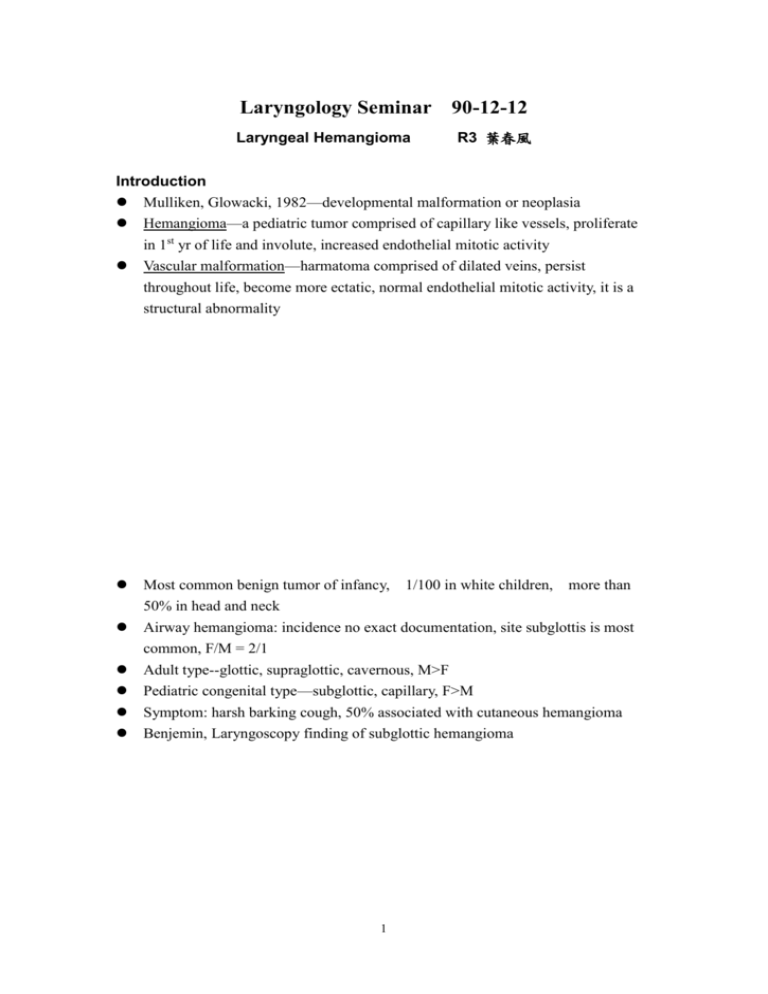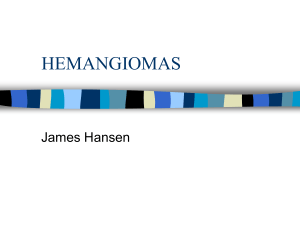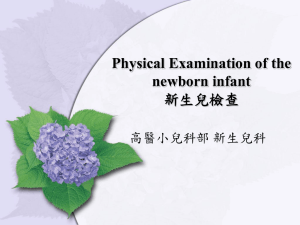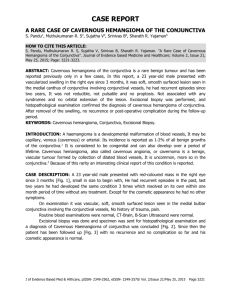Laryngeal Hemangioma R3 葉春風
advertisement

Laryngology Seminar 90-12-12 Laryngeal Hemangioma R3 葉春風 Introduction Mulliken, Glowacki, 1982—developmental malformation or neoplasia Hemangioma—a pediatric tumor comprised of capillary like vessels, proliferate in 1st yr of life and involute, increased endothelial mitotic activity Vascular malformation—harmatoma comprised of dilated veins, persist throughout life, become more ectatic, normal endothelial mitotic activity, it is a structural abnormality Most common benign tumor of infancy, 1/100 in white children, more than 50% in head and neck Airway hemangioma: incidence no exact documentation, site subglottis is most common, F/M = 2/1 Adult type--glottic, supraglottic, cavernous, M>F Pediatric congenital type—subglottic, capillary, F>M Symptom: harsh barking cough, 50% associated with cutaneous hemangioma Benjemin, Laryngoscopy finding of subglottic hemangioma 1 Natural history of hemangioma Early proliferation—rapid neonatal proliferation throughout first year of life, Late proliferation—tubules of plump endothelial cells with very small lumen, less target chromophore Early involution—endothelium flattening, vascular channel more obvious, progressive deposition of fibrofatty tissue.—may take up to 4 yrs Late involution—thin walled vesselsin collagen , reticular tissue, islands of adipose tissue—usually > 5 y/o, Malignant transformation—5 equivocal skin hemangioma case, 1 larungeal hemangioma transformed to angiosarcoma (McRae, 1990) Treatment Observation Mortality rate of subglottic hemangioma 40 to 70% Tracheotomy, Intubation Mortality rate 45 % when tracheotomy alone If prolonged, speech and language delay Corticosteroid Used for juvenile hemangioma since early 1960s, Katz 1968, Sadan, 1996—60 infants in 24 yrs 53/60 was < 6 m/o , oral prednisone 3-5 mg/kg/day in 4 divided dises, not exceeding 40 mg/day for 2 weeks, then taper by 1/2 or 2/3. Discontinued at 6-8 weeks, some 10 weeks, one 12 weeks, one 30 weeks. 47/60 one course, 8/60 two course, 5/60 three course. Most in OPD. Side effect—Moon face 32/60, growth delay in 2/60 but catchup growth later, osteoporosis in 1/60. Behavior change in all, irritability, frequent crying, increased appetite. Mechanism—increase the sensitivity of of arteriole and precapillary to some vasoconstrictors(Hiles, 1968), some steroid inhibit angiogenesis in the presence of heparin fragment(Folkman, 1984) 2 Interferon alfa 2a (Ohlms, 1994) First as antiviral agent, but found to improve Kaposi’s sarcoma in AIDS For Hemangioma—Ezekowitz, 1992 . White, 1989. Mechanism—Block angiogenic stimulus(eg. FGF). Inhibit endothelium proliferation and migration Indication—infants with life threatening airway hemangioma unresponsive to steroid and laser therapy (extensive lesion, multiple airway site) Method—3 million U/m2/day subcutaneous injection , admission for 48 to 72 hrs. prolonged therapy for 9-14 months Toxcicity—cheek skin sloughing, anti IFN antibody, rebound growth of hemangioma in one case of early withdraw. Initial low grade fever, Minor elevated liver enzyme. Lacking long-term followup data Not useful to vascular malfomation, effect is delayed, not appropriate for life threatening airway compromise Injection of sclerosing agent or steroid Meeuwis, Hoeve, 1990—injection of steroid and intubated for 3-4 weeks Some will need 10 injections and intubated for more than 3 months Radiation Therapy External beam Benjamin, 1983—early in his series, from 375-600 rad. Not used after 1973. Radioactive gold grain Holborow and Mott, 1972 Small cylinder, 2.5 mm long, 0.8mm diameter Dose 1 mCi Half life 4.7 day Give maximal tumor dose and minimize thyroid dose 1 mm from center 22000 rads, 1 cm from center 200 rads Risk—possibility of radiation induced thyroid malignancy. 3 Cryosurgery, First by Schecter, Biller, 1972 Electrocautery First by Kim, Hendren, 1976. Fulguration. Davidoff, Filston 1992 Procedure—mask anesthesia, Stortz .newborn telescopic bronchoscope, 3F ureteral cath with tip 2 cm cut, a stainless steel wire in the cath, must under direct vision. Cut 1/3 or 1/2 of mass, nasotracheal intubated for 3-7 days, bronchoscopy again before extubation , steroid for 5 weeks Inexpensive (compared to cryoprobe$4000, CO2 laser$70000) Surgical excision Abbeele, Narcy, 1999—20 pt from 1991 to 1997. Most are bilateral or circular, no response to laser , steroid dependent, steroid resistent, steroid side effect. Classical LTR—with anterior cartilage graft and post op Silastic stenting. 6/20. 5/6 anterior cartilage graft, 2/5 posterior graft. Silastic stent removed 36+-10 days after op. Decanulated 74 +-25 days after op. Preop steroid 85 days, post op steroid 48 days. Complications: 1/6 left laryngeal palsy, 3/6 subglottic granulation, 2/3 need CO2 laser. Result: all subglottis normal SS-LTR(Single stage LTR)—14/20 12/14 use anterior cartilage graft, post op stay in PICU, mild sedated for 2-3 days. No paralysis. all extubated 7.5+-3 days after op. Preop steroid 84 days, post op steroid 20 days. Complications: 3/14 subglottic granulation, 1/3 need CO2 laser.(maybe related to intubated > 10 days, without use of antireflux therapy) . Result: 12/14 subglottis normal. 2/14 20-30% narrowing. 4 Laser Pulsed yellow light laser 578-585 nm Selective absorption by hemoglobin, melanin. But can avoid damaging epithelium or mucosa by manipulating parameters Copper vapor laser Flashlamp pumped –dye laser No report of use in laryngeal hemangioma CO2 laser first by Healy, 1980 Healy, 1994—31 subglottic hemanfioma pt in 10 yrs, (21 F. 20 M.), 28/31 tx with CO2 laser, requiring average 2 treatment Procedure—GA, Venturi jet ventilation with Sanders needle at pressures of 8-20 psi, short acting barbiturate, muscle relaxant, narcotic analgesics. Laser at pulse mode 2-5 W, avoid circumferential mucosa injury. Post op care—observe in ICU, humidification to prevent crusting, epinephrine inhalation, IV steroid to prevent subglottic edema. IV steroid dexamethasone 1.5mg/kg/day, oral prednisone 2mg/kg/day, used from days to 1 yr. 6/26 had tracheotomy during tx, 20/26 allow no tracheotomy. Complication—subglottic stenosis (20%, 4/20 no tracheotomy), 2/4 need tracheotomy and laryngotracheal reconstruction, Argon laser First by Parkin, Dixon, 1983 Selective absorption by hemoglobin and melanin 490 to 514 nm stongly absorbed by melanin Most used in port wine stain, 3 subglottic hemangioma patient, 2/3 got severe post op eschar and need repeated intubation for eschar removal, 1/2 developed scarring 5 KTP laser Ahsan, Stein, 2001 532 nm, delivered via fiberoptic fibers absorbed by hemoglobin 1990-1998, 6 patient, average 1.7 treatment Procedure—GA, fiber in side channel of rigid ventilating bronchoscope, continuous mode, 5 W, single or repeated pulse mode at 0.5 secs, to 60-70 patency, preoperative dexamethasone 0.5 mg/kg, Result—1/6 got GrI subglottic stenosis, No tracheotomy Nd:YAG laser 1064 nm, deep penetration up to 1 cm, scatter of laser energy Labruna, Anand, 1996—continuous mode, 15-20 W, transmitted through a 2.5 mm fiber to phtocoagulate, contact mode for resection. Good for low flow vascular malformation (the adult type hemangioma) Superselective embolization (SSE) Holinger, 1988—a case of diffuse upper respiratory tract hemangioma Technically difficult in small infant Risk—particles into ICA via anastomosis, normal tissue injury, sepsis, hemorrhage, stroke, postembolization edema as source of obstruction. 6 Cyclophosphamide Reference 1. Madgy D. Ahsan SF. Kest D. Stein I.The application of the potassium-titanyl-phosphate (KTP) laser in the management of subglottic hemangioma.Archives of Otolaryngology -- Head & Neck Surgery. 127(1):47-50, 2001 Jan. 2. Lomeo P. McDonald J. Finneman J. Adult laryngeal hemangioma: report of four cases.Ear, Nose, & Throat Journal. 79(8):594, 597-8, 2000 Aug. 3. Van Den Abbeele T. Triglia JM. Lescanne E. Roger G. Nicollas R. Ployet MJ. Garabedian EN. Narcy P. Surgical removal of subglottic hemangiomas in children.Laryngoscope. 109(8):1281-6, 1999 Aug. 4. Wiatrak BJ. Reilly JS. Seid AB. Pransky SM. Castillo JV. Open surgical excision of subglottic hemangioma in children. International Journal of Pediatric Otorhinolaryngology. 34(12):191-206, 1996 Jan. 5. Yellin SA. LaBruna A. Anand VK. Nd:YAG laser treatment for laryngeal and hypopharyngeal hemangiomas: a new technique. Annals of Otology, Rhinology & Laryngology. 105(7):510-5, 1996 Jul. 6. Sie KC. McGill T. Healy GB. Subglottic hemangioma: ten years' experience with the carbon dioxide laser. Annals of Otology, Rhinology & Laryngology. 103(3):167-72, 1994 Mar. 7. Davidoff AM. Filston HC. Treatment of infantile subglottic hemangioma with electrocautery. Journal of Pediatric Surgery. 7 27(4):436-9, 1992 Apr. 8. McRae RD. Gatland DJ. McNab Jones RF. Khan S. Malignant transformation in a laryngeal hemangioma. Annals of Otology, Rhinology & Laryngology. 99(7 Pt 1):562-5, 1990Jul. 9. Konior RJ. Holinger LD. Russell EJ. Superselective embolization of laryngeal hemangioma. Laryngoscope. 98(8 Pt 1):830-4, 1988 Aug. 10. Benjamin B. Carter P. Congenital laryngeal hemangioma. Annals of Otology, Rhinology & Laryngology. 92(5 Pt 1):448-55, 1983 Sep-Oct. 11. Brodsky L. Yoshpe N. Ruben RJ. Clinical-pathological correlates of congenital subglottic hemangiomas. Annals of Otology, Rhinology, & Laryngology - Supplement. 105:4-18,1983 Jul-Aug. 8









